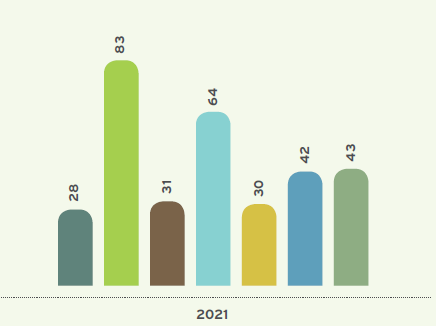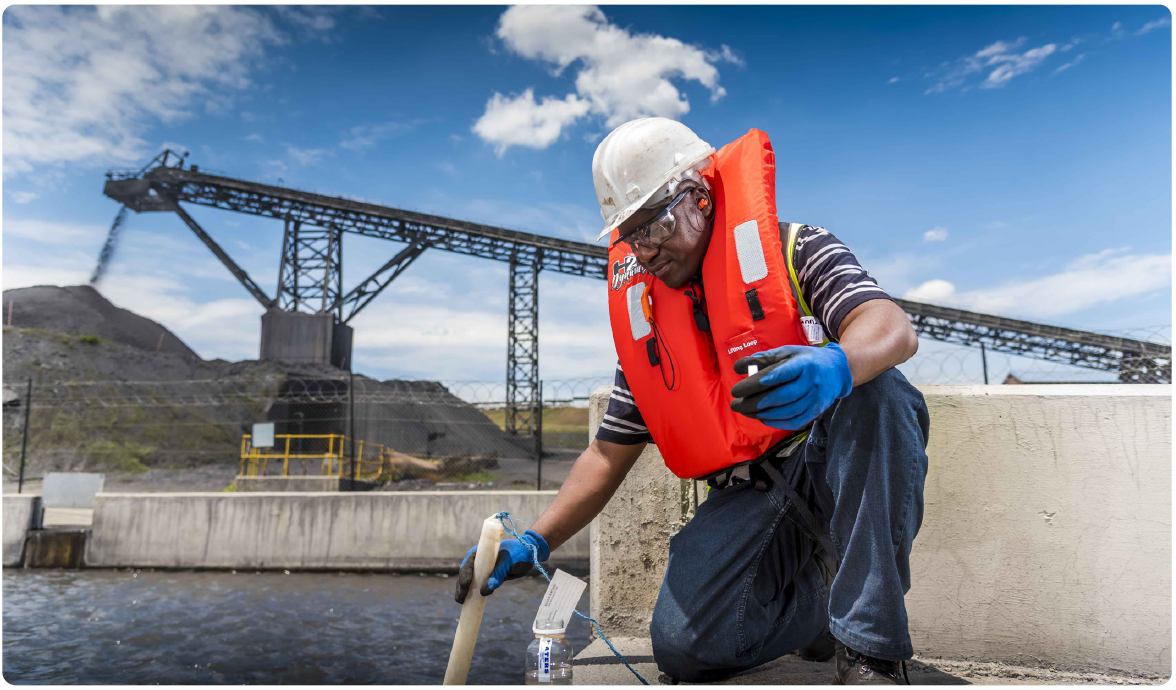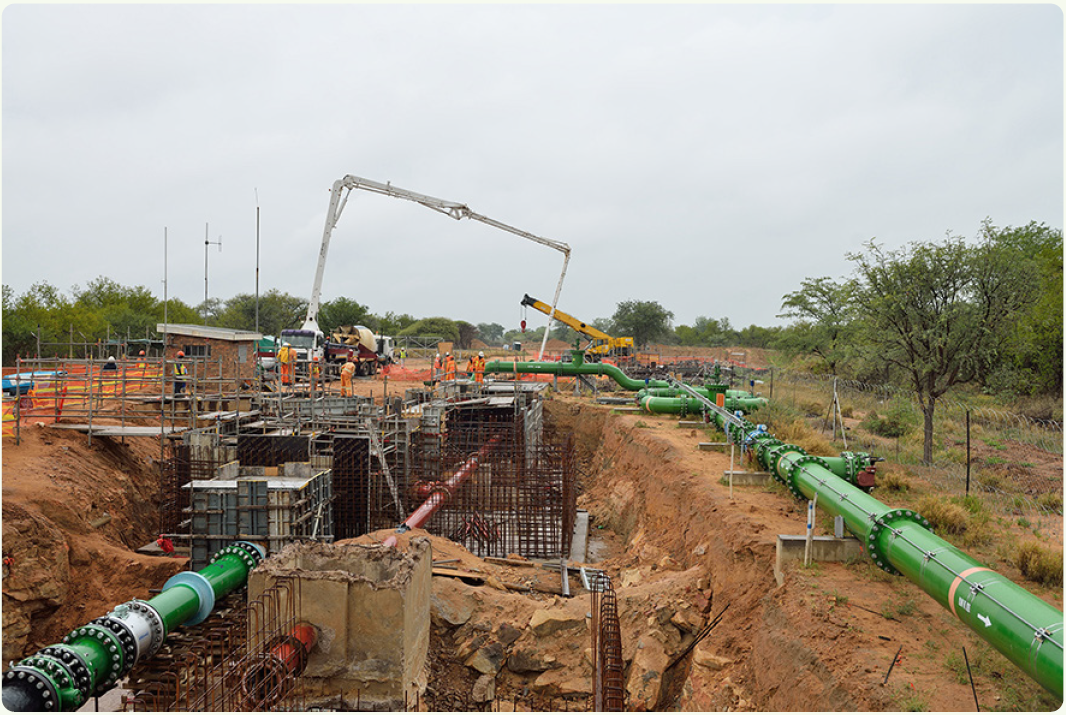Currently viewing: Water security management | Next: Waste management
Water is a strategic natural resource for the country and our business. South Africa is a water-scarce country, and experiences the effects of climate change, particularly increased temperatures and rainfall variability. Furthermore, the International Council on Mining and Metals identified several risks relating to mining operations due to chronic changes in precipitation extremes and droughts. These include flooding, which results in increased run-off and erosion and drought induced water shortages. Therefore, it is our responsibility to effectively manage our water supply to safeguard various mine aspects to enable production, dust mitigation to prevent dust fallout on the surrounding communities, effective pollution prevention and health and hygiene considerations.
Water management is a critical component of a mine's overall operational and environmental management.
We uphold our licence to operate through:
Our water management vision is to be a leader in water stewardship – innovatively planning and managing our water resources.
We are committed to responsible and sustainable water use as enshrined in our water management policy. The policy focuses on efficient water reuse and recycling, and aligns with the legislated environmental framework mainly governed by the NWA, supported by the integrated water resource management hierarchy issued by the DWS to prioritise mine and waste management decisions and actions. The hierarchy informs our policy and strategy on mine and wastewater management by:
We implement this policy through our water management standard, which covers mining and industrial water use. This standard articulates our integrated water and waste management plan across each mine's lifecycle, including planning, construction, operation, decommissioning, closure and rehabilitation phases. The standard also reflects management's vision to:
From 2022, we will measure and link the achievement of our water-related targets to our group-wide STI scheme as a driver of our Climate Change Response strategy and Sustainable Growth and Impact strategy. As part of our TCFD process, the financial and business resilience implications of water security will be effectively quantified. We are in the process of establishing an internal price on water that considers social and environmental water costs. Once this internal price is set, we will be able to account for the real price of water and hedge against risk and supply chain disruption as the price of water increases.
Group water strategy
Our group water strategy was approved in 2017, aiming for excellence in:
We implemented a comprehensive programme on responsible and sustainable water management at our BUs, focusing on water use and related risks. This includes security of supply, water efficiency and cost management in terms of current and anticipated regulatory compliance. We support the programme with research and skills development as well as water issues awareness through ongoing communication and training.
We manage water-related risks, minimise impacts and operate efficiently by:
Reducing, reusing and recycling water in line with water conservation plans that support the National Water Resource Strategy
Equitable distribution of water resources, considering both business growth and sustainable consumption
Our commitment to protecting and improving water quality by discharging water treated in our BUs through our reverse-osmosis water treatment plant at Matla
Water use and storage projects
Water management projects
Water use and storage projects
Investigating possibilities of alternate water sources, such as the Mokolo Crocodile Water Augmentation Project phase 2 for the Grootegeluk mining and processing operations.
Water management projects
Water-saving projects include innovative leak detection, repair and pressure monitoring.
We continue collaborating with other mining houses and universities through the Coaltech research initiative in projects that provide guidelines on sustainable mine water management and mine closure. Our collaboration also affords accurate final land use planning.
The Mine Water Coordinating Body, formed in 2017, further strengthens our public-private collaboration by providing a platform to align our mine water management plans with the National Water Resource Strategy and investigate regional solutions in the Olifants River catchment of Mpumalanga.
Implementing our policy and practices at an operational level is overseen by the sustainability manager supported by the water team and on-site environmental specialists under the leadership of the executive head: sustainability.
Water is crucial to all our operations and changes in availability or quality will affect production, efficiency and cost.
We continued implementing and improving our water management efficiency, mitigation, maintenance and conservation measures during the year. Highlights include:
We were challenged by above-normal rainfall during 2021, which negated the short-term risk of water shortage. We will continue carefully managing excess water.
Data provided is verified as part of the SD assurance process by PwC.
Water security is the backbone of our water strategy. The fundamental principle of our water management approach is sustainable use of water resources and to actively engage with our fellow water users in the catchment to collectively manage the resource.
Without controlled efforts to maintain water security, we face the risk of production stoppages, financial loss and WUL noncompliances, further impacting the reissue of WULs. The knock-on effect leads to competition for scarce resources, a considerable loss of investment opportunities, and damage to our biodiversity efforts.
We manage security through implementing water conservation plans that holistically assess the impact of available water in the face of climate change. Our mitigation plans include water treatment plants and optimising water storage infrastructure.
Our coal operations require good quality freshwater for some of our beneficiation processes, washing activities, and employee domestic use. The balance of our water use can come from localised rainfall storage, recycling, reuse and reclaimed sources. We protect our freshwater, as interruptions to this supply could pose a risk to operational continuity and profitability.
Cennergi's two windfarms source water from licensed boreholes and rainwater harvesting. Bottled potable water is provided to Cennergi's operational employees and contractors.
Our primary water source is surface water (including rainwater and water from rivers and lakes), followed by groundwater and third-party sources. Our surface water usage has stabilised after an increase in 2020 due to changes in in-pit conditions at Grootegeluk trapping water in the backfill material reducing our recycling ratio, and the ramp-up of our Belfast operation.
We carefully manage and treat our water discharges. At Matla, we use reverse osmosis to treat contaminated process water to potable standards, and two sewerage treatment plants release treated sewage effluent. Discharges have decreased 30% due to lower underground dewatering and treatment at Matla in 2021 and increased ability to reuse treated sewage effluent in the beneficiation processes as part of our water conservation efforts.
Our total water consumption (water withdrawals less water discharged) for 2021 was 10 281ML. This is a 6% decrease from 2020 due to lower surface water utilisation and increased water efficiency.
| Water withdrawal and discharge (ML) | 2021 | 2020 | 2019 |
| Total water withdrawal | 10 890 | 11 798 | 9 021 |
|---|---|---|---|
| Surface water | 8 165 | 8 877 | 5 869 |
| Groundwater | 1 312 | 1 368 | 2 072 |
| Third-party water | 1 413 | 1 553 | 1 081 |
| Total water discharged | 609 | 874 | 1 339 |
| Water consumption | 10 281 | 10 924 | 7 682 |
We refined our water intensity targets in 2020 and developed a new five-year target in line with industry norms and site-specific conditions. We lowered our previous aggregated target of 200L/t to 180L/t. This target is well below the coal industry average of 380L/t. It supports our strategy to reduce water intake in line with the DWS's drive to increase water conservation and reclamation.
Our overall water efficiency rate deteriorated by 9% due to the higher storages of water at all our operations during 2021 driven by high rainfall.
| Water intensity (L/t) | Water consumption (kL) | |||||||
| Water intensity | Target (L/t) by 2025 |
2021 | 2020 | 2019 | 2021 | 2020 | 2019 | |
| Mpumalanga | ||||||||
| Belfast | 250 | 237 | 132 | 28 | 654 132 | 416 628 | 29 501 | |
| Dorstfontein East | 280 | 227 | 116 | 168 | 256 735 | 219 140 | 383 541 | |
| Dorstfontein West | 130 | 60 | 66 | 88 | 81 064 | 111 798 | 112 009 | |
| Forzando | 180 | 157 | 124 | 70 | 364 853 | 406 326 | 281 797 | |
| Leeuwpan | 100 | 27 | 38 | 25 | 106 380 | 228 085 | 165 241 | |
| Matla | 230 | 190 | 190 | 159 | 1 120 930 | 1 168 683 | 950 292 | |
| Limpopo | ||||||||
| Grootegeluk | 170 | 149 | 150 | 99 | 7 681 560 | 8 198 145 | 5 364 282 | |
| Gauteng | ||||||||
| FerroAlloys | 21 000kL | n/a | n/a | n/a | 15 175 | 14 494 | 18 725 | |
| Total group | 180 | 149 | 137 | 99 | 10 280 829 | 10 763 299 | 7 305 388 | |
Our target is 38% overall water recycling ratio, defined as the total water recycled divided by total water used (including recycled water), substantially higher than the coal industry average of 6%, as outlined in the national water use efficiency benchmarks of the DWS. Our overall recycling ratio of 46% in 2021 is well within our target range.
Water recycling ratio (%)


*ECC = Divestment completed in September 2021.

Slimes dam at our Grootegeluk BU
Our tailings management system focuses on the operation, monitoring and decommissioning of the tailings dams and uses comprehensive risk-based management and governance systems in line with internationally recognised good practice. The company has a drive to align the management of tailings with the Global Industry Standard on Tailings Management.
Our dam assets have clean and polluted water. Dams with a wall height exceeding 5m and a capacity exceeding 50 000m3 are considered dams with a safety risk according to the South African Dam Safety Legislation. Only a few clean and dirty water dams meet above minimum requirements to be classified with the DWS as dams with a safety risk. Once classified, the dams are categorised in categories I, II and III according to their risk potential. A category III dam has the highest hazard potential. The safety classification of the slimes dam was revised in 2020 from a medium to either a high or very high hazard level. Due to the revision, there was a breach analysis executed to determine zone of influence in a failure of the dam, and a team was established to review the risks. The aim is to review current controls to manage these risks, review the current operation and develop a permanent solution.
The table below shows all dams categorised as dams with a safety risk by DWS.
| BU | Category I | Category II | ||||
| Matla | – | Brine ponds | ||||
| Grootegeluk | – | Cyclic ponds | ||||
| ECC* | – | Dorstfontein East PCD 1, 2 and 3 | ||||
| Leeuwpan | – | Witklip dam | ||||
| Durnacol | Durnacol dam number 4 | Durnacol dam number 7 Langley dam number 2 Langley dam number 3 |
||||
| Tshikondeni | Unwa dam | – | ||||
* Divestment concluded in September 2021.
We will continue our efforts to improve our water efficiency through various infrastructure projects and enhancements.
To support the achievement of our Sustainable Growth and Impact strategy, we have set water-related targets and aligned these to our STI scheme. This is currently in the pilot phase and will be implemented in 2022.

Water monitoring at ECC in Mpumalanga

Construction in progress on the Mokolo water project
We have entered into a collaborative water augmentation project agreement phase 2 with the DWS and Eskom in waterscarce Waterberg. The projected outcome of this project will be a supplementary 400 000m3 increase in water supply to the Grootegeluk mine, bringing our total allocation to 8 million m3 per annum, and will enable the further development of the mineral and energy prospects in the larger Waterberg region. This project is planned for completion in 2026.
 Report Index
Report Index Integrated Report 2021
Integrated Report 2021
